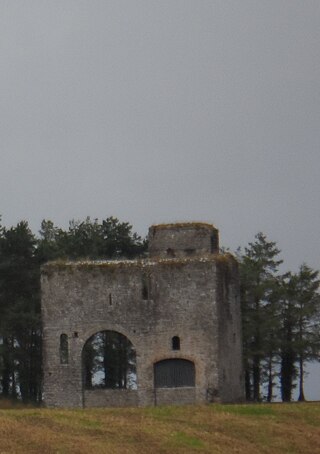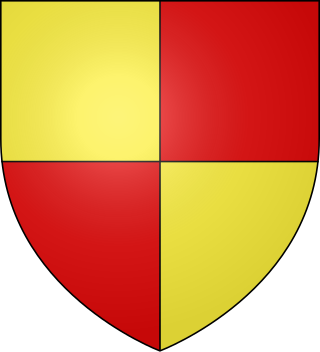The Lord High Steward of Ireland is a hereditary Great Officer of State in the United Kingdom, sometimes known as the Hereditary Great Seneschal. The Earls of Shrewsbury have held the office since the 15th century. Although the Irish Free State, later the Republic of Ireland, became independent in 1922, the title remained the same, rather than reflecting the region of Northern Ireland, which remains within the United Kingdom.
James Butler, 4th Earl of Ormond was the son of James Butler, 3rd Earl of Ormond. He was called 'The White Earl', and was esteemed for his learning. He was the patron of the Irish literary work, 'The Book of the White Earl'. His career was marked by his long and bitter feud with the Talbot family.
Events from the year 1539 in Ireland.
James FitzEustace of Harristown, 3rd Viscount Baltinglass (1530–1585) James FitzEustace, the eldest son of Rowland Eustace, 2nd Viscount Baltinglass and Joan, daughter of James Butler, 8th Baron Dunboyne. He was born in 1530 and died in Spain in 1585. Baltinglass's family was traditionally associated with the FitzGerald family, the earls of Kildare, but prudently remained loyal to Henry VIII during the "Silken Thomas" Rebellion of 1534–35. For their loyalty, they were granted additional lands. Later in the 1540s Thomas FitzEustace, James's grandfather, was created first Viscount Baltinglass by a grateful king. But like many other old English Pale families, the FitzEustaces later became disillusioned.
Sir Gerald Aylmer was an Irish judge in the time of Henry VIII, who played a key part in enforcing the Dissolution of the Monasteries. His numerous descendants included the Barons Aylmer.

Richard Wogan was an Irish judge and cleric who held the office of Lord Chancellor of Ireland, and also served as a soldier.
The High Sheriff of Wexford was the British Crown's judicial representative in County Wexford, Ireland from the 16th century until 1922, when the office was abolished in the new Irish Free State and replaced by the office of Wexford County Sheriff. The sheriff had judicial, electoral, ceremonial and administrative functions and executed High Court Writs. In 1908, an Order in Council made the Lord-Lieutenant the Sovereign's prime representative in a county and reduced the High Sheriff's precedence. However, the sheriff retained his responsibilities for the preservation of law and order in the county. The usual procedure for appointing the sheriff from 1660 onwards was that three persons were nominated at the beginning of each year from the county and the Lord Lieutenant then appointed his choice as High Sheriff for the remainder of the year. Often the other nominees were appointed as under-sheriffs. Sometimes a sheriff did not fulfil his entire term through death or other event and another sheriff was then appointed for the remainder of the year. The dates given hereunder are the dates of appointment. All addresses are in County Wexford unless stated otherwise.
Sir William Welles was an English-born statesman and judge in fifteenth-century Ireland, who held the office of Lord Chancellor of Ireland. He was the younger brother of Lionel de Welles, 6th Baron Welles. Lionel was a prominent supporter of the House of Lancaster, who was killed at the Battle of Towton on 29 March 1461.
Thomas Le Boteller, or Thomas Butler, nicknamed Thomas Bacach i.e. Thomas the Lame, was the illegitimate son of the 3rd Earl of Ormond, and a leading political figure in early fifteenth-century Ireland. He held the offices of Lord Chancellor of Ireland, Lord Deputy of Ireland and Prior of Kilmainham. In his own lifetime, he was a highly unpopular statesman, who was accused by his numerous enemies of treason. He is now chiefly remembered as a professional soldier, who was present at the Siege of Rouen in 1418–19. He had previously fought in the sanguinary conflict known as the Battle of Bloody Bank near Dublin in 1402.

Sir Richard FitzEustace (c.1380–1445) was an Irish statesman who twice held the office of Lord Chancellor of Ireland.
James Cornwalsh was an Irish judge who held the office of Chief Baron of the Irish Exchequer. He was a political figure of considerable importance in fifteenth-century Ireland, and a supporter of the Lord Lieutenant of Ireland, James Butler, 4th Earl of Ormond. He was murdered as a result of a feud over the possession of Baggotrath Castle, near Dublin.
Christopher Bernevall, or Barnewall (1370–1446) was an Irish politician and judge of the fifteenth century, who held the offices of Vice-Treasurer of Ireland and Lord Chief Justice of Ireland. He was deeply involved in the political controversies of his time, and was a leading opponent of the powerful Anglo-Irish magnate James Butler, 4th Earl of Ormond. His elder son Nicholas also held office as Lord Chief Justice, and his younger son Robert was created the first Baron Trimleston.
John Chevir or Chevyr was an Irish judge and politician of the fifteenth century. He held the offices of Lord Chief Justice of Ireland and Master of the Rolls in Ireland, and was also one of the first recorded Speakers of the Irish House of Commons.

William Tynbegh, or de Thinbegh (c.1370-1424) was an Irish lawyer who had a long and distinguished career as a judge, holding office as Chief Justice of all three of the courts of common law and as Lord High Treasurer of Ireland. His career is unusual both for the exceptionally young age at which he became a judge, and because left the Bench to become Attorney General for Ireland, but later returned to judicial office.
Giles Thorndon was a senior official of the English Crown in the fifteenth century, who was noted for his long and loyal service to the House of Lancaster and for his troubled and unsuccessful career as Lord Treasurer of Ireland.

Thomas Talbot was a wealthy landowner and judge in fifteenth-century Ireland. He was the head of the prominent Talbot family of Malahide Castle. His descendants acquired the title Baron Talbot de Malahide, and he himself was recognised by the Crown as Lord of Malahide, although this was not a hereditary title. He was also Admiral of the Port of Malahide. By the time of his death he held lands in four counties and was one of the principal landowners in the Pale. After his death, there was a lawsuit between his widow Elizabeth and a Talbot relative, James, over possession of some of his properties.
Robert Dyke, Dyck or Dyche was an English-born cleric and judge who held high office in fifteenth-century Ireland. He was appointed to the offices of Archdeacon of Dublin, Chancellor of the Exchequer of Ireland, Lord High Treasurer of Ireland, and Master of the Rolls in Ireland, as well as holding several Church benefices.
Edward Somerton, or Somertoune was an Irish barrister and judge who held the offices of Serjeant-at-law (Ireland) and judge of the Court of King's Bench (Ireland) and the Court of Common Pleas (Ireland). He was born in Ireland, possibly in Waterford, although he lived much of his life in Dublin. By 1426 he was a clerk in the Court of Chancery (Ireland), and was paid 26 shillings for his labours in preparing writs and enrolment of indentures,. In 1427 he is recorded in London studying law at Lincoln's Inn. He returned to Ireland and was again in the Crown service by 1435, when he was ordered to convey lands at Beaulieu, County Louth to Robert Chambre, one of the Barons of the Court of Exchequer (Ireland). He was appointed King's Serjeant for life in 1437; he also acted as counsel for the city of Waterford, a position subsequently held by another future judge, John Gough.
Sir James Alleyn was an Irish judge of the fifteenth century. He held the offices of Speaker of the Irish Privy Council, Chief Justice of the Common Pleas for Ireland and Lord Chief Justice of Ireland.
John Gough, or John Gogh was an Irish barrister, judge and Crown official of the fifteenth century.




